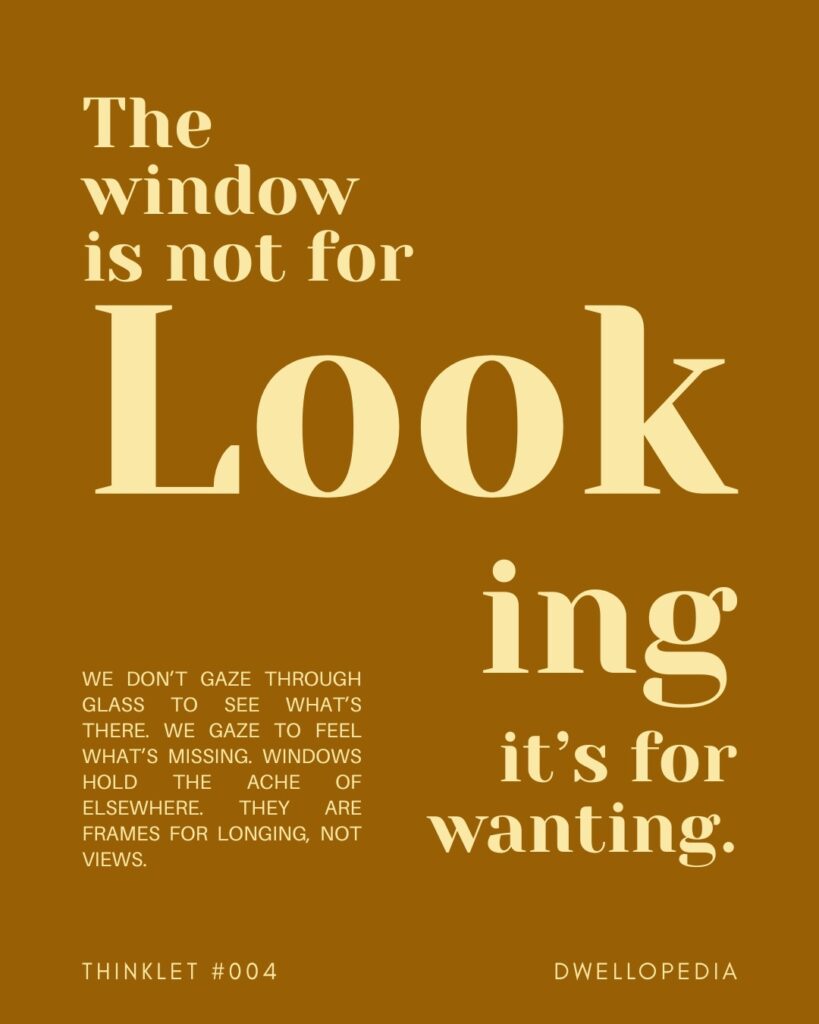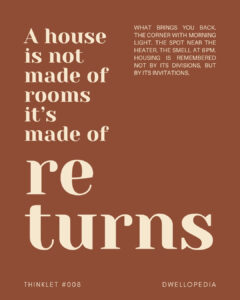A window is often seen as a portal to the outside world—a transparent plane through which we observe what lies beyond our walls. Yet, to understand a window solely as a means of looking is to miss its deeper architectural and emotional significance. The window is not for looking—it is for wanting. It is less a frame for the visible than a stage for desire, a silent testament to the ache of elsewhere.
Why do our eyes linger at windows, even when the view is unremarkable? Because through the glass, we do not just see; we feel the absence, the horizon just beyond reach. Windows are invitations to imagine what is missing: a neighbor’s warm glow at dawn, a sliver of sky framed by branches, a distant mountain shrouded in mist. They do not deliver answers but pose continuous questions—what lies beyond? What could be? What do we yearn for?
This yearning is architectural as much as it is emotional. The window holds and shapes our desires, casting shadows of possibility into the mind’s interior spaces. It bridges inside and outside, presence and absence, enclosure and expansiveness. How does this tension shape the lived experience of home? How might architects design windows not simply as light-givers or views, but as evocative thresholds of longing and connection?
Housing Unfolded: Transforming the Practice
What if housing design embraced the window not as a simple aperture for vision but as a complex frame of longing? This perspective invites a radical rethinking of spatial experience—one that values emotional resonance as much as physical dimension. How would architecture change if windows were crafted to evoke desire, anticipation, and connection, rather than just provide daylight or ventilation?
Materiality becomes vital in this practice. The texture of glass, its opacity or clarity, the depth of its reveal, the weight of its frame—all influence how the window mediates between inside and outside. Can architects design windows that suggest mystery, that soften or distort views to heighten curiosity? How might reflective or colored glass enrich this emotional architecture, creating layers of perception and memory?
Light, refracted and filtered through the window, shapes mood and meaning. Consider morning light casting long shadows that shift throughout the day—a silent dialogue between nature and built form. How might design harness these temporal rhythms to deepen spatial intimacy and longing? Could windows become moments of ritual, where inhabitants pause and connect with the world beyond their walls?
Spatially, windows are thresholds rather than mere openings. They frame vistas but also frame experience—moments of stillness, anticipation, and wonder. What if housing layouts prioritized views not for their scenic value but for their capacity to evoke yearning? How could the placement and scale of windows shape social dynamics—between neighbors, between family members, between solitude and community?
Culturally, windows carry symbolic weight—eyes of the home, watchers of the street, mirrors of identity. How does this symbolism interact with the architecture of longing? Could designs cultivate windows as poetic intermediaries, honoring cultural narratives of openness, invitation, or protection?
The ripple effects extend into design thinking itself. Embracing windows as vessels of desire challenges architects to move beyond functionalism, to engage with architecture as emotional poetry. How might this reshape education, practice, and discourse around housing design, spatial experience, and architectural philosophy?
Beyond Boundaries: Layered Understandings
Viewing the window as a frame for longing refracts into multiple interpretive layers. Sustainability prompts us to consider how windows mediate environmental flows—light, air, heat—yet also emotional flows. How might ecological design balance the functional with the poetic, creating windows that sustain body and soul?
From a social equity lens, windows can be sites of inclusion or exclusion. Do they open homes to community or shield them in isolation? How might architecture use window design to foster social connection, visibility, and shared experience, challenging boundaries of privacy and accessibility?
Memory and cultural identity intertwine in the window’s frame. Windows witness life’s passage, holding histories of gaze and gesture. How can architectural design honor these temporal layers, embedding memory within spatial experience?
Technological advances—from smart glass to augmented reality—offer new ways to modulate window experience. Yet how do we preserve the window’s poetic mystery amid these innovations? Can technology amplify longing, or does it risk flattening it into data and control?
Each perspective reveals the window’s richness as a site of layered meaning—ecological, social, cultural, and technological—inviting architects to embrace complexity and nuance in their designs and theories.
Conclusion
To say the window is not for looking but for wanting is to celebrate architecture’s capacity to frame desire, to craft spaces that beckon beyond their physical limits. This thinklet plants a seed for architects and thinkers to nurture windows as poetic thresholds—spaces of anticipation, connection, and longing that enrich the experience of home.
In the subtle play of light and shadow, in the framed glimpse of sky or neighbor’s light, windows invite us into a continuous conversation with what is absent and what might be. They hold the power not to answer but to ask, not to satisfy but to provoke.
As you reflect on this thought, consider: How might your designs craft windows that evoke longing, that invite pause and imagination? How can architecture embrace desire as a vital dimension of spatial experience?
The power of this thinklet lies not in certainty but in wonder. What will your windows reveal—not just to the eyes, but to the heart?







